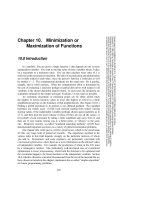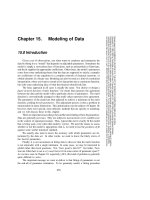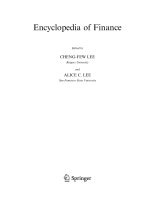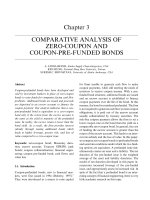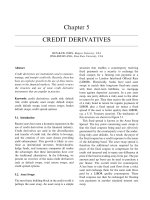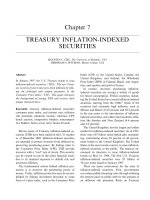Encyclopedia of Finance Part 1 pptx
Bạn đang xem bản rút gọn của tài liệu. Xem và tải ngay bản đầy đủ của tài liệu tại đây (9.3 MB, 311 trang )
Encyclopedia of Finance
Edited by
CHENG-FEW LEE
Rutgers University
and
ALICE C. LEE
San Francisco State University
Encyclopedia of Finance
The Editors
Cheng-Few Lee, Rutgers University, USA
Alice C. Lee, San Franscisco State University, USA
ADVISORY BOARD
James R. Barth, Auburn University and Milken Institute, USA
Ivan Brick, Rutgers University, USA
Wayne Ferson, Boston College, USA
Joseph E. Finnerty, Universty of Illinois, USA
Martin J. Gruber, New York University, USA
George Kaufman, Layola University, USA
John Kose, New York University, USA
Robert A. Schwartz, City University of New York, USA
Encyclopedia of Finance
Edited by
CHENG-FEW LEE
Rutgers University
and
ALICE C. LEE
San Francisco State University
Library of Congress Cataloging-in-Publication Data
Encyclopedia of finance / edited by Cheng-Few Lee and Alice C. Lee
p.cm.
Includes bibliographical references and index.
ISBN-13: 978-0-387-26284-0 (alk. paper)
ISBN-10: 0-387-26284-9 (alk.paper)
ISBN-10: 0-387-26336-5 (e-book)
1. Finance-Encyclopedias. I. Lee, Cheng F. II. Lee, Alice C.
HG151.E625 2006
332’.03-dc22 2005049962
ß 2006 Springer Science+Business Media, Inc.
All rights reserved. This work may not be translated or copied in whole or in part without the written
permission of the publisher (Springer ScienceþBusiness Media, Inc., 233 Spring Street, New York, NY
10013, USA), except for brief excerpts in connection with reviews or scholarly analysis. Use in connection
with any form of information storage and retrieval, electronic adaptation, computer software, or by
similar or dissimilar methodology now known or hereafter developed is forbidden.
The use in this publication of trade names, trademarks, service marks and similar terms, even if they are
not identified as such, is not to be taken as an expression of opinion as to whether or not they are subject
to proprietary rights
Printed in the United States of America.
9 8 7 6 5 4 3 2 1 SPIN 11416555
springer.com
ABOUT THE EDITORS
Cheng-Few Lee is a Distinguished Professor of Finance at Rutgers Busi-
ness School, Rutgers University and was chairperson of the Department
of Finance from 1988–1995. He has also served on the faculty of the
University of Illinois (IBE Professor of Finance) and the University of
Georgia. He has maintained academic and consulting ties in Taiwan,
Hong Kong, China and the United States for the past three decades. He
has been a consultant to many prominent groups including, the American
Insurance Group, the World Bank, the United Nations and The Marmon
Group Inc., etc.
Professor Lee founded the Review of Quantitative Finance and Accounting
(RQFA) in 1990 and the Review of Pacific Basin Financial Markets and
Policies (RPBFMP) in 1998, and serves as managing editor for both
journals. He was also a co-editor of the Financial Review (1985–1991)
and the Quarterly Review of Economics and Business (1987–1989).
In the past thirty-two years, Dr. Lee has written numerous textbooks
ranging in subject matter from financial management to corporate
finance, security analysis and portfolio management to financial analysis,
planning and forecasting, and business statistics. Dr. Lee has also pub-
lished more than 170 articles in more than twenty different journals in
finance, accounting, economics, statistics, and management. Professor
Lee has been ranked the most published finance professor worldwide
during 1953–2002.
Alice C. Lee is an Assistant Professor of Finance at San Francisco State
University. She has a diverse background, which includes engineering,
sales, and management consulting. Her primary areas of teaching and
research are corporate finance and financial institutions. She is coauthor
of Statistics for Business and Financial Economics, 2e (with Cheng-Few
Lee and John C. Lee) and Financial Analysis, Planning and Forecasting,
2e (with Cheng-Few Lee and John C. Lee, forthcoming in 2006). In
addition, she has co-edited other annual publications including Advances
in Investment Analysis and Portfolio Management (with Cheng-Few Lee).
TABLE OF CONTENTS
PREFACE . . . . . . . . . . . . . . . . . . . . . . . . . . . . . . . . . . . . . . . . . . . . . . . . xiii
LIST OF CONTRIBUTORS xv
PART I: TERMINOLOGY AND ESSAYS 1
Cheng-Few Lee, Rutgers University, USA
Alice C. Lee, San Francisco State University, USA
PART II: PAPERS 297
1. Deposit Insurance Schemes 299
James R. Barth, Auburn University and Milken Institute, USA
Cindy Lee, China Trust Bank, USA
Triphon Phumiwasana, Milken Institute, USA
2. Gramm-Leach-Bliley Act: Creating a New Bank for a
New Millennium 307
James R. Barth, Auburn University and Milken Institute, USA
John S. Jahera, Auburn University, USA
3. Comparative Analysis of Zero-coupon and Coupon-pre-funded
Bonds 314
A. Linda Beyer, Alaska Supply Chain Integrators, USA
Ken Hung, National Dong Hwa University, Taiwan
Suresh C. Srivatava, University of Alaska Anchorage, USA
4. Intertemporal Risk and Currency Risk 324
Jow-Ran Chang, National Tsing Hua University, Taiwan
Mao-Wei Hung, National Taiwan University, Taiwan
5. Credit Derivatives 336
REN-RAW CHEN, Rutgers University, USA
Jing-Zhi Huang, Penn State University, USA
6. International Parity Conditions and Market Risk 344
Thomas C. Chiang, Drexel University, USA
7. Treasury Inflation-Indexed Securities 359
Quentin C. Chu, University of Memphis, USA
Deborah N. Pittman, Rhodes College, USA
8. Asset Pricing Models 364
Wayne E. Ferson, Boston College, USA
9. Conditional Asset Pricing 376
Wayne E. Ferson, Boston College, USA
10. Conditional Performance Evaluation 384
Wayne E. Ferson, Boston College, USA
11. Working Capital and Cash Flow 393
Joseph E. Finnerty, University of Illinois, USA
12. Evaluating Fund Performance within the Stochastic
Discount Factor Framework 405
J. Jonathan Fletcher, University of Strathclyde, UK
13. Duration Analysis and Its Applications 415
Iraj J. Fooladi, Dalhousie University, Canada
Gady Jacoby, University of Manitoba, Canada
Gordon S. Roberts, York University, Canada
14. Loan Contract Terms 428
Aron A. Gottesman, Pace University, USA
15. Chinese A and B Shares 435
Yan He, Indiana University Southeast, USA
16. Decimal Trading in the U.S. Stock Markets 439
Yan He, Indiana University Southeast, USA
17. The 1997 Nasdaq Trading Rules 443
Yan He, Indiana University Southeast, USA
18. Reincorporation 447
Randall A. Heron, Indiana University, USA
Wilbur G. Lewellen, Purdue University, USA
19. Mean Variance Portfolio Allocation 457
Cheng Hsiao, University of Southern California, USA
Shin-Huei Wang, University of Southern California, USA
20. Online Trading 464
Chang-Tseh Hsieh, University of South Mississippi, USA
viii TABLE OF CONTENTS
21. A Note on the Relationship among the Portfolio Performance
Indices under Rank Transformation 470
Ken Hung, National Dong Hwa University, Taiwan
Chin-Wei Yang, Clarion University, USA
Dwight B. Means, Jr., Consultant, USA
22. Corporate Failure: Definitions, Methods, and Failure
Prediction Models 477
Jenifer Piesse, University of London, UK and University of
Stellenbosch, South Africa
Cheng-Few Lee, National Chiao Tung University, Taiwan and
Rutgers University, USA
Hsien-chang Kuo, National Chi-Nan University and Takming
College, Taiwan
Lin Lin, National Chi-Nan University, Taiwan
23. Risk Management 491
Thomas S.Y. Ho, Thomas Ho Company, Ltd., USA
Sang Bin Lee, Hanyang University, Korea
24. Term Structure: Interest Rate Models 501
Thomas S.Y. Ho, Thomas Ho Company, Ltd., USA
Sang Bin Lee, Hanyang University, Korea
25. Review of REIT and MBS 512
Cheng-Few Lee, National Chiao Tung University, Taiwan and
Rutgers University, USA
Chiuling Lu, Yuan Ze University, Taiwan
26. Experimental Economics and the Theory of Finance 520
Haim Levy, Hebrew University, Israel
27. Merger and Acquisition: Definitions, Motives, and Market
Responses 541
Jenifer Piesse, University of London, UK and University of
Stellenbosch, South Africa
Cheng-Few Lee, National Chiao Tung University, Taiwan and
Rutgers University, USA
Lin Lin, National Chi-Nan University, Taiwan
Hsien-Chang Kuo, National Chi-Nan University and Takming
College, Taiwan
TABLE OF CONTENTS ix
28. Multistage Compund Real Options: Theory and Application . . . 555
William T. Lin, Tamkang University, Taiwan
Cheng-Few Lee, National Chiao Tung University, Taiwan
and Rutgers University, USA
Chang-Wen Duan, Tamkang University, Taiwan
29. Market Efficiency Hypothesis 585
Melody Lo, University of Southern Mississippi, USA
30. The Microstructure/Micro-finance Approach to Exchange Rates 591
Melody Lo, University of Southern Mississippi, USA
31. Arbitrage and Market Frictions 596
Shashidhar Murthy, Rutgers University, USA
32. Fundamental Tradeoffs in the Publicly Traded
Corporation 604
Joseph P. Ogden, University at Buffalo, USA
33. The Mexican Peso Crisis 610
Fai-Nan Perng, The Central Bank of China, Taiwan
34. Portfolio Performance Evaluation 617
Lalith P. Samarakoon, University of St. Thomas, USA
Tanweer Hasan, Roosevelt University, USA
35. Call Auction Trading 623
Robert A. Schwartz, Baruch College, USA
Reto Francioni, Swiss Stock Exchange, Switzerland
36. Market Liquidity 630
Robert A. Schwartz, City University of New York, USA
Lin Peng, City University of New York, USA
37. Market Makers 634
Robert A. Schwartz, City University of New York, USA
Lin Peng, City University of New York, USA
38. Structure of Securities Markets 638
Robert A. Schwartz, City University of New York, USA
Lin Peng, City University of New York, USA
39. Accounting Scandals and Implications for Directors:
Lessons from Enron 643
x TABLE OF CONTENTS
Pearl Tan, Nanyang Technology University, Singapore
Gillian Yeo, Nanyang Technology University, Singapore
40. Agent-Based Models of Financial Markets 649
Nicholas S. P. Tay, University of San Francisco, USA
41. The Asian Bond Market 655
Khairy Tourk, Illinois Institute of Technology, USA
42. Cross-Border Mergers and Acquisitions 664
Geraldo M. Vasoncellos, Lehigh University, USA
Richard J. Kish, Lehigh University, USA
43. Jump Diffusion Model 676
Shiu-Huei Wang, University of Southern California, USA
44. Networks, Nodes, and Priority Rules 689
Daniel G. Weaver, Rutgers University, USA
45. The Momentum Trading Strategy 700
K.C. John Wei, Hong Kong University of Science
and Technology, Hong Kong
46. Equilibrium Credit Rationing and Monetary Non Neutrality in
a Small Open Economy 705
Ying Wu, Salisbury University, USA
47. Policy Coordination between Wages and Exchange Rates in
Singapore 715
Ying Wu, Salisbury University, USA
48. The Le Chatelier Principle of the Captial Market
Equilibruim 724
Chin-Wei Yang, Clarion University of Pennsylvania, USA
Ken Hung, National Dong Hwa University, Taiwan
John A. Fox, The Fox Consultant Incorporated, USA
49. MBS Valuation and Prepayments 729
C. H. Ted Hong, BeyondBond Inc., USA
Wen-Ching Wang, Robeco Investment Management, USA
50. The Impacts of IMF Bailouts in International Debt Crises 744
Zhaohui Zhang, Long Island University, USA
Khondkar E. Karim, Rochester Institute of Technology, USA
TABLE OF CONTENTS xi
PART III: APPENDIX 751
Cheng-Few Lee, Rutgers University, USA
Alice C. Lee, San Francisco State University, USA
APPENDIX A. Derivation of Dividend Discount Model 753
APPENDIX B. Derivation of DOL, DFL AND DCL 755
APPENDIX C. Derivation of Crossover Rate 757
APPENDIX D. Capital Budgeting Decision with Different Lives . . . 759
APPENDIX E. Derivation of Minimum-Variance Portfolio 761
APPENDIX F. Derivation of an Optimal weight Portfolio using
the Sharpe Performance Measure 763
APPENDIX G. Applications of the Binomial Distribution
to Evaluate Call Options 767
PART IV: REFERENCES 773
PART V: INDEX 815
Subject Index 817
Author Index 843
xii TABLE OF CONTENTS
PREFACE
Finance has become one of the most important and popular subjects in
management school today. This subject has progressed tremendously in
the last forty years, integrating models and ideas from other areas such as
physics, statistics, and accounting. The financial markets have also rap-
idly expanded and changed extensively with improved technology and the
ever changing regulatory and social environment. For example, there has
been a rapid expansion of financial concepts, instruments, and tools due
to increased computing power and seemingly instantaneous information
sharing through networks. The internationalization of businesses and
economies will continue to impact the field of finance. With all this
progress and expansion in finance and society, we thought that it
would be useful to put together an updated comprehensive encyclopedia
as a reference book for both students and professionals, in an attempt to
meet the demand for a key source of fundamental finance terminology
and concepts.
This Encyclopedia of Finance contains five parts. Part I includes finance
terminology and short essays. Part II includes fifty important finance
papers by well know scholars and practitioners such as; James R. Barth,
Ren-Raw Chen, Thomas C. Chiang, Quentin C. Chu, Wayne E. Ferson,
Joseph E. Finnerty, Thomas S.Y. Ho, C.H. Ted Hong, Cheng Hsiao,
Jing-Zhi Huang, Mao-wei Hung, John S. Jahera Jr, Haim Levy, Wilbur
G. Lewellen, Joseph P. Ogden, Fai-Nan Peng, Gordon S. Roberts,
Robert A. Schwartz, K.C. John Wei, and Gillian Yeo, among others.
Topics covered in both Part I and Part II include fundamental subjects
such as financial management, corporate finance, investment analysis
and portfolio management, options and futures, financial institutions,
international finance, and real estate finance. Part III contains appendi-
ces which discuss and derive some fundamental finance concepts and
models; Part IV lists references; and Part V provides both subject and
author indexes.
Fifty papers included in Part II can be classified as eight groups as
follows:
a) Investment analysis and portfolio management (papers 3, 7, 10, 12,
19, 21, 29, 31, 34, 40, 45, and 48);
b) Financial management and corporate finance (papers 11, 18, 22, 26,
27, 28, 32, 39, and 42);
c) International finance (papers 4, 6, 15, 30, 33, 41, 42, 47, and 50);
d) Microstructure (papers 16, 17, 20, 30, 35, 36, 37, 38, and 44);
e) Asset pricing (papers 8, 9, 10, 12, and 34);
f) Financial Institutions and Markets (papers 1, 2, 13, 24, and 46);
g) Derivatives (papers 5, 28, and 43);
h) Real estate finance (papers 14, 25, and 49);
i) Risk Management (papers 4, 5, 6, 22, 23, 24, and 39).
For both undergraduate and graduate students, this encyclopedia is a
good supplementary material for above listed finance courses. In add-
ition, this encyclopedia can also be a good supplementary material for
financial accounting courses. We believe that this encyclopedia will not
only be useful to students but also for professors and practitioners in the
field of finance as a reference.
We would like to thank the contributors for willingness to share their
expertise and their thoughtful essays in Part II. We would like to thank
Ms. Judith L. Pforr and Ms. Candace L. Rosa, of Springer for their
coordination and suggestions to this book. Finally, we would also like to
express our gratitude to our secretaries Ms. Mei-Lan Luo, Ms. Sue Wang,
Ms. Ting Yen, and Ms. Meetu Zalani, for their efforts in helping us pull
together this tremendous repository of information.
We hope that the readers will find the encyclopedia to be an invaluable
resource.
By
Cheng-Few Lee
Alice C. Lee
xiv PREFACE
CONTRIBUTORS
James R. Barth, Auburn University and Milken Institute, USA
A. Linda Beyer, Alaska Supply Chain Integrators, USA
Jow-Ran Chang, National Tsing Hua University, Taiwan
Ren-Raw Chen, Rutgers University-New Brunswick, USA
Thomas C. Chiang, Drexel University, USA
Quentin C. Chu, University of Memphis, USA
Chang-Wen Duan, Tamkang University, Taiwan
Wayne Ferson, Boston College, USA
Joseph E. Finnerty, University of Illinois, USA
Jonathan Fletcher, University of Strathclyde, UK
Iraj J. Fooladi, Dalhousie University, Canada
John A. Fox, The Fox Consultant Incorporated, USA
Reto Francioni, The Swiss Stock Exchange, Switzerland
Aron A. Gottesman, Pace University, USA
Tanweer Hasan, Roosevelt University, USA
Yan He, Indiana University Southeast, USA
Randall A. Heron, Indiana University, USA
Thomas S. Y. Ho, Thomas Ho Company, Ltd., USA
C.H. Ted Hong, BeyondBond Inc., USA
Cheng Hsiao, University of Southern California, USA
Chang-Tseh Hsieh, University of South Mississippi, USA
Jing-Zhi Huang, Penn State University, USA
Ken Hung, National Dong Hwa University, Taiwan
Mao-Wei Hung, National Taiwan University, Taiwan
Gady Jacoby, University of Manitoba, Canada
John S. Jahera Jr, Auburn University, USA
Khondkar E. Karim, Rochester Institute of Technology, USA
Richard J. Kish, Lehigh University, USA
Hsein-Chang Kuo, National Chi-Nan University, Taiwan
Alice C. Lee, San Francisco State University, USA
Cheng-Few Lee, Rutgers University-New Brunswick, USA
Cindy Lee, China Trust Bank, USA
Sang Bin Lee, Hanyang University, Korea
Haim Levy, Hebrew University, Israel
Wilbur G. Lewellen, Purdue University, USA
Lin Lin, National Chi-Nan University, Taiwan
William T. Lin, Tamkang University, Taiwan
Melody Lo, University of Southern Mississippi, USA
Chiuling Lu, Yuan Ze University, Taiwan
Dwight B. Means, Dr. Dwight B. Means Jr. Consultant, USA
Shashidhar Murthy, Rutgers University-Camden, USA
Joseph P. Ogden, State University of New York at Buffalo, USA
Lin Peng, City University of New York, USA
Fai-Nan Perng, The Central Bank of China, Taiwan
Triphon Phumiwasana, Milken Institute, USA
Jenifer Piesse, University of London, UK
Deborah N. Pittman, Rhodes College, USA
Gordon S. Roberts, York University, Canada
Lalith P. Samarakoon, University of St. Thomas, USA
Robert A. Schwartz, City University of New York, USA
Suresh Srivatava, University of Alaska Anchorage, USA
Pearl Tan, Nanyang Technology University, Singapore
Nicholas S. P. Tay, University of San Francisco, USA
Khairy Tourk, Illinois Institute of Technology, USA
Geraldo M. Vasoncellos, Lehigh University, USA
Shin-Huei Wang, University of Southern California, USA
Wen-Ching Wang, Robeco Investment Management, USA
Daniel G. Weaver, Rutgers University, USA
K.C. John Wei, Hong Kong University of Science and Technology, HK
Ying Wu, Salisbury University, USA
Chin-Wei Yang, Clarion University of Pennsylvania, USA
Gillian Yeo, Nanyang Technology University, Singapore
Zhaohui Zhang, Long Island University-C. W. Post, USA
xvi CONTRIBUTORS
PART I: Terminologies and
Essays
A
1. Abnormal Return
Return on a stock beyond what would be the
expected return that is predicted by market move-
ments alone. [See also Cumulative abnormal return
(CAR)]
2. Absolute Cost Advantage
Absolute cost advantages can place competitors at a
cost disadvantage, even if the scale of operations is
similar for both firms. Such cost advantages can
arise from an advanced position along the learning
curve, where average costs decline as cumulative
output rises over time. This differs from economies
of scale, which involves the relationship between
average costs and the output level per period of
time. A firm that enters a market segment early can
learn about the production and distribution process
first and make more efficient use of assets, technol-
ogy, raw inputs, and personnel than its competitors.
In such cases, the firm can frequently reduce costs
and prices and maintain market leadership. Similar
advantages can result from possessing proprietary
technology that is protected by patents.
Some firms seek to maintain absolute cost ad-
vantages by entering foreign market. Early entry
can allow the firm to gain experience over its com-
petitors, as it can more efficiently track foreign
market trends and technologies and disseminate
new methods throughout the firm.
3. Absolute Priority of Claims
In case of liquidation of a firm’s assets, the rule
requires satisfaction of certain claims prior to the
satisfaction of other claims. The priority of claims
in liquidation or reorganization typically takes the
following order:
1. Special current debt, which includes trustee
expenses, unpaid wages that employees have
earned in the 90 days preceding bankruptcy
(not to exceed $2,000 for any one case), and
contributions to employee benefit plans that
have fallen due within the 180 days preceding
bankruptcy.
2. Consumer claims on deposits not exceeding
$900 per claim.
3. Tax claims.
4. Secured creditors’ claims, such as mortgage
bonds and collateral trust bonds, but only to
the extent of the liquidating value of the
pledged assets.
5. General creditors’ claims, including amounts
owed to unsatisfied secured creditors and all
unsecured creditors, but only to the extent of
their proportionate interests in the aggregate
claims of their classes.
6. Preferred stockholders’ claims, to the extent
provided in their contracts, plus unpaid divi-
dends.
7. Residual claims of common stockholders.
The priority of claims order and amounts are
arbitrary, and no conclusions should be drawn
about the relative merits of how workers, con-
sumers, the government, creditors, and owners
are treated.
4. Absolute Priority Rule (APR)
Establishes priority of claims under liquidation.
Once the corporation is determined to be bank-
rupt, liquidation takes place. The distribution of
the proceeds of the liquidation occurs according to
the following priority: (1) Administration ex-
penses; (2) Unsecured claims arising after the filing
of an involuntary bankruptcy petition; (3) Wages,
salaries, and commissions; (4) Contributions to
employee benefit plans arising within 180 days
before the filing date; (5) Consumer claims; (6)
Tax claims; (7) Secured and unsecured creditors’
claims; (8) Preferred stockholders’ claims; (9)
Common stockholders’ claims. APR is similar to
absolute priority of claims.
5. Absolute Purchasing Power Parity
Absolute purchasing power parity states that ex-
change rates should adjust to keep purchasing
power constant across currencies. In general, how-
ever, absolute purchasing power parity does not
hold, in part because of transportation costs, tar-
iffs, quotas, and other free trade restrictions. A
more useful offshoot of absolute purchasing
power parity is relative purchasing power parity.
[See also Relative purchasing power parity]
6. Accelerated Cost Recovery System (ACRS)
A system used to depreciate accelerated assets for
tax purposes. The current system, enacted by the
1986 Tax Reform Act, is very similar to ACRS
established in 1981. The current modified acceler-
ated cost recovery system (MACRS) specifies the
depreciable lives (recovery periods) and rates for
each of several classes of property. It should be
noted that this higher level of depreciation is offset
by reclassifying individual assets into categories
with longer life. [See also Modified accelerated
cost recovery system]
7. Accelerated Depreciation
A method of computing depreciation deductions for
income tax that permits deductions in early years
greater than those under straight line depreciation.
It includes sums of year’s digits, units of production
and double decline methods. [See also Double-de-
clining balance depreciation, Sum-of-the-year’s-
digits depreciation and Unit of production method]
8. Account Activity
Transactions associated with a deposit account,
including home debits, transit checks, deposits,
and account maintenance.
9. Account Analysis
An analytical procedure for determining whether a
customer’s deposit account or entire credit-deposit
relationship with a bank is profitable. The proced-
ure compares revenues from the account with the
cost of providing services.
10. Account Executive
A representative of a brokerage firm who processes
orders to buy and sell stocks, options, etc., for a
customer’s account.
11. Account Maintenance
The overhead cost associated with collecting infor-
mation and mailing periodic statements to deposi-
tors.
12. Accounting Analytic
The use of financial ratios and fundamental analy-
sis to estimate firm specific credit quality examin-
ing items such as leverage and coverage measures,
with an evaluation of the level and stability of
earnings and cash flows. [See also Credit scoring
model]
13. Accounting Beta
Project betas can be estimated based on accounting
beta. Accounting measures of return, such as
EBIT/Total Assets, can be regressed against a
profitability index that is based on data for the
stocks in the S&P 500 or some other market index:
EBIT
TA
!
project, i, t
¼ a
i
þ Ab
i
EBIT
TA
!
market, t
þ«
i, t
,
where the slope estimate; Ab
i
, is the accounting
beta.
Accounting information by product line or div-
ision is available in various Securities and Ex-
change Commission (SEC) filings that are
4 ENCYCLOPEDIA OF FINANCE
required of publicly traded firms. Although a
firm’s multidivisional structure may disqualify it
from being a pure play comparable, it may include
divisional data in its public SEC filing that would
be useful for estimating an accounting beta.
14. Accounting Break-Even
Accounting break-even occurs when accounting
revenues equal accounting expenses so that pretax
income (and hence net income) equals zero. It tells
us how much product must be sold so that the
firm’s overall accounting profits are equal to
accounting expenses. Ignoring working capital ef-
fects,
OCF ¼ NI þ Depreciation:
At accounting break-even, net income (NI) is
zero, so Operating Cash Flow (OCF) equals
the periodic depreciation expense. Substituting
this into the general break-even (Q
*
) formula,
we obtain accounting break-even quantity
(Q
accounting
Ã
) as:
Q
Ã
accounting
¼
FC þ Dep
p À vc
,
where FC ¼ fixed cost; vc ¼ variable cost per unit;
p ¼ price per unit; and Dep ¼ depreciation.
The denominator, (p–vc), is called the contribu-
tion margin. The accounting break-even quantity
is given by the sum of the fixed cost and depreci-
ation divided by the contribution margin.
Accounting break-even tells us how much product
must be sold so that the firm’s overall accounting
profits are not reduced.
15. Accounting Earnings
Earnings of a firm as reported in its income state-
ment. Accounting earnings are affected by several
conventions regarding the valuation of assets such
as inventories (e.g., LIFO versus FIFO treatment)
and by the way some expenditures such as capital
investments are recognized over time (such as de-
preciation expenses).
16. Accounting Income
Income described in terms of accounting earnings,
based upon records of transactions in company
books kept according to generally accepted prin-
ciples (GAAP). Accountants generally measure rev-
enues and expenses based on accruals and deferrals
rather than cash flows and, in turn, measure the net
income of the firm by matching its revenues with the
costs it incurred to generate those revenues.
Theoretically, financial analysis should consider
economic income rather than accounting earnings
to determine the value of the firm, since economic
income represents the firm’s true earnings and cash
flows. [See also Economic income] However, since
economic income is not directly observable, ana-
lysts generally use accounting earnings as a proxy.
The relationship between economic income and
accounting earnings can be related by the follow-
ing equation:
Accounting Income ¼
Economic Income (permanent component)
þ Error (Transitory component):
17. Accounting Insolvency
Total book liabilities exceed total book value of
assets. A firm with negative net worth is insolvent
on the books.
18. Accounting Liquidity
The ease and quickness with which assets can be
converted to cash. Current assets are the most
liquid and include cash and those assets that will
be turned into cash within a year from the date of
the balance sheet. Fixed assets are the least liquid
type of assets.
19. Accounting Rate of Return (ARR)
The accounting rate of return (ARR) method
(which is one of the methods for capital budgeting
decision) computes a rate of return for a project
PART I: TERMINOLOGIES AND ESSAYS 5
based on a ratio of average project income to
investment outlay (usually either the total initial
investment or the average investment is used). Pro-
jects with accounting returns exceeding a manage-
ment-determined minimum return are accepted;
those with returns below the cutoff are rejected.
To compute the accounting rate of return, we use
the following ratio:
ARR ¼
Average annual net income
Total initial investment
:
Similar to the payback method, the accounting rate
of return method has none of the four desired
selection method characteristics. [See also Payback
method] First, it doesn’t even use cash flows; it
relies on accounting income. Second, it ignores
time value of money concepts. Third, it states no
clearly defined, objective decision criterion; like the
payback method, its cutoff depends on the discre-
tion of management. Fourth, ARR tells us abso-
lutely nothing about the impact of a project on
shareholder wealth.
20. Accounting, Relationship to Finance
The accounting function, quantifies, to a certain
extent, the economic relationships within the firm
and provides data on which management bases its
planning, controlling, and operating decisions. Like
accounting, finance deals with value and the monet-
ary resources of the organization. [See also Finance]
21. Accounting-Based Beta Forecasting
Elgers (1980) proposed accounting-based beta
forecasting. Accounting-based beta forecasts rely
upon the relationship of accounting information
such as the growth rate of the firm, earning before
interest and tax (EBIT), leverage, and the dividend
pay-out as a basis for forecasting beta. To use
accounting information in beta forecasting, the
historical beta estimates are first cross-sectionally
related to accounting information such as growth
rate, variance of EBIT, leverage, accounting beta,
and so on:
b
i
¼ a
0
þ a
1
X
1i
þ a
2
X
2i
þ a
j
X
ji
þÁÁÁþ a
m
X
mi
,
where b
i
is the beta coefficient for ith firm which is
estimated in terms of market model. X
ji
is the jth
accounting variables for ith firm, and a
j
is the
regression coefficient.
22. Accounting-Based Performance Measures
To evaluate firm performance, we can use account-
ing-based measures such as sales, earnings per
share, growth rate of a firm. However, accounting
performance measures are vulnerable to distortion
by accounting principles, whose application may
be somewhat subjective (such as when to recognize
revenue or how quickly to depreciate assets). Ra-
ther than present an unbiased view of firm per-
formance, accounting statements may be oriented
toward the perspective that management wants to
present. Additionally, accounting-based perform-
ance measures are always historical, telling us
where the firm has been.
23. Accounts Payable
Money the firm owes to suppliers. These are pay-
ments for goods or services, such as raw materials.
These payments will generally be made after pur-
chases. Purchases will depend on the sales forecast.
Accounts payable is an unfunded short-term debt.
24. Accounts Receivable
Money owed to the firm by customers; the
amounts not yet collected from customers for
goods or services sold to them (after adjustment
for potential bad debts).
25. Accounts Receivable Financing
A secured short-term loan that involves either the
assigning of receivables or the factoring of receiva-
bles. Under assignment, the lender has a lien on the
receivables and recourse to the borrower. Factor-
6 ENCYCLOPEDIA OF FINANCE
ing involves the sale of accounts receivable. Then
the purchaser, call the factor, must collect on recei-
vables. [See also Factoring]
26. Accounts Receivable Turnover
Credit sales divided by average accounts receiv-
able. In general, a higher accounts receivable turn-
over ratio suggests more frequent payment of
receivables by customers. The accounts receivable
turnover ratio is written as:
Accounts Receivable Turnover
¼
Sales
Accounts Receivable
:
Thus, if a firm’s accounts receivable turnover ratio
is larger than the industry average, this implies
that the firm’s accounts receivable are more effi-
ciently managed than the average firm in that
industry.
27. Accreting Swap
A swap where the notional amount increases over
the life of the swap. It is used to hedge interest rate
risk or agreements with a rising principal value,
such as a construction loan.
28. Accrual
The accumulation of income earned or expense
incurred, regardless of when the underlying cash
flow is actually received or paid.
29. Accrual Bond
A bond that accrues interest but does not pay
interest to the investor until maturity when accrued
interest is paid with the principal outstanding.
30. Accrual Swap
An interest rate swap where interest on one side
accrues only when the floating reference rate is
within certain range. The range can be maintained,
fixed, or reset periodically during the entire life of
the swap.
31. Accrued Interest
Interest income that is earned but not yet received.
Alternatively, it refers to pro-rated portion of a
bond’s coupon payment (c) since the previous cou-
pon date with (m–d) days have passed since the
last coupon payment; the accrued interest is
c(m Àd)=m, where m and d represent total days
and days left to receive coupon payment, respect-
ively. In a semiannual coupon, if m ¼ 182 days, d ¼
91 days and c ¼ $60, then the accrued interest is
calculated as:
($30)
182 À91
182
¼ $15:
32. Accumulated Benefit Obligation (ABO)
FASB Statement 87 specifies that the measure of
corporate pension liabilities to be used on the cor-
porate balance sheet in external reports is the accu-
mulated benefit obligation (ABO), which is the
present value of pension benefits owed to employees
under the plan’s benefit formula absent any salary
projections and discounted at a nominal rate of
interest.
33. Accumulation Phase
During the accumulation phase, the investor con-
tributes money periodically to one or more open-
end mutual funds and accumulates shares. [See
also Variable annuities]
34. Acid-Test Ratio
A measure of liquidity from reported balance sheet
figures with targeted minimum value of one. Cal-
culated as the sum of cash, marketable securities,
and accounts receivable divided by current liabil-
ities. [See also Quick ratio]
PART I: TERMINOLOGIES AND ESSAYS 7
35. Acquisition
Assuming there are two firms, Firm A and Firm B.
Acquisition is a form of business combination in
which Firm B buys Firm A, and they both remain
in existence; Firm B as the parent and Firm A as
the subsidiary.
Mergers or acquisitions are also ways for a pri-
vate firm to raise equity capital by selling all or
part of the firm to another corporation. [See also
Merger] Another firm may pay an attractive price
for the equity of the private firm, especially if the
private firm has a good strategic fit with the
buyer’s products and plans, or if the purchase
offers a foreign corporation easy entry into the
US market. Acquisitions can be negotiated to
allow the firm’s managers to retain their current
positions or to receive lucrative consulting con-
tracts.
Another advantage of a merger or acquisition is
when the investor is a large corporation with deep
pockets and a willingness to help the firm grow.
Such a situation can provide financing for the
firm’s present and foreseeable future needs. Rather
than spending time canvassing banks and equity
investors for capital, management can concentrate
on doing what it presumably does best: managing
the firm to make it grow and succeed.
The drawback to a merger or acquisition is a
loss of control. Although a seemingly straightfor-
ward consequence, this can be a large stumbling
block for a business with a tradition of family
ownership or for a group of founding entrepre-
neurs who consider the firm their ‘‘baby.’’ Unless
the private equity owners get an exceptional deal
from the new owner, a merger or sale causes
them to give up the return potential of their busi-
ness. If the company does grow and succeed after
the sale, someone else – the new investor – will reap
the benefits. If the original owners stay with the
new owner, they may become frustrated by the
lack of attention from their new partners if the
firm is only a small part of the acquirer’s overall
business.
36. Active Bond Portfolio Management
An investment policy whereby managers buy and
sell securities prior to final maturity to speculate
on future interest rate movements. In addition,
managers can also identify the relative mispricing
within the fixed-income market.
37. Active Management
Attempts to achieve portfolio returns more than
commensurate with risk, either by forecasting
broadmarkettrendsor byidentifyingparticularmis-
priced sectors of a market or securities in a market.
38. Active Portfolio
In the context of the Treynor-Black model (See
Treynor and Black, 1973), the portfolio formed by
mixing analyzed stocks of perceived nonzero alpha
values. This portfolio is ultimately mixed with the
passive market index portfolio. [See also Alpha and
Active bond portfolio management]
39. Activity Charge
A service charge based on the number of checks
written by a depositor.
40. Activity Ratios
Activity ratios measure how well a firm is using its
resources. Four activity ratios are analyzed: (1)
inventory turnover, (2) average collection period,
(3) fixed-asset turnover, and (4) total asset turnover.
Inventory turnover (sales/inventory) measures
how well a firm is turning over its inventory. The
average collection period (receivables/sales per
day) measures the accounts-receivable turnover.
The fixed-asset turnover (sales to net fixed assets)
measures the turnover of plant and equipment – a
measure of capacity utilization. Total-asset turn-
over (sales/total assets) measures how efficiently
total assets have been utilized.
8 ENCYCLOPEDIA OF FINANCE
41. Acts of Bankruptcy
Bankruptcy includes a range of court procedures in
the US that may result in the firm being liquidated
or financially reorganized to continue operations.
This may occur voluntarily if the firm permits a
petition for bankruptcy, or a creditor’s petition
may force the firm into the courts. Such a petition
by a creditor charges the firm with committing one
of the following acts of bankruptcy: (1) committing
fraud while legally insolvent, (2) making preferen-
tial disposition of firm assets while legally insolvent,
(3) assigning assets to a third party for voluntary
liquidation while insolvent, (4) failing to remove a
lien on the firm within 30 days while insolvent, (5)
appointment of a receiver or trustee while insolvent,
or (6) written admission of insolvency.
42. Additions to Net Working Capital
A component of the cash flow of the firm, along
with operating cash flow and capital spending.
These cash flows are used for making investments
in net working capital.
Total cash flow of the firm ¼ Operating cash flow
À Capital spending ÀAdditions to net
working capital:
43. Add-on Interest
Add-on interest means that the total interest owed
on the loan, based on the annual stated interest
rate, is added to the initial principal balance before
determining the periodic payment. This kind of
loan is called an add-on loan. Payments are deter-
mined by dividing the total of the principal plus
interest by the number of payments to be made.
When a borrower repays a loan in a single, lump
sum, this method gives a rate identical to annual
stated interest. However, when two or more pay-
ments are to be made, this method results in an
effective rate of interest that is greater than the
nominal rate. Putting this into equation form, we
see that:
PV ¼ S
N
t¼1
Future Flows
(1 þInterest Rate)
t
,
where PV ¼ the present value or loan amount; t
¼ the time period when the interest and principal
repayment occur; and N ¼ the number of
periods.
For example, if a million-dollar loan were repaid
in two six-month installments of $575,000 each, the
effective rate would be higher than 15 percent,
since the borrower does not have the use of the
funds for the entire year. Allowing r to equal the
annual percentage rate of the loan, we obtain the
following:
$1,000,000 ¼
$575,000
1 þ
r
2
1
þ
$575,000
1 þ
r
2
2
:
Using a financial calculator, we see that r equals
19.692 percent, which is also annual percentage
return (APR). Using this information, we can ob-
tain the installment loan amortization schedule as
presented in the following table.
44. Add-On Rate
A method of calculating interest charges by apply-
ing the quoted rate to the entire amount advanced
to a borrower times the number of financing
periods. For example, an 8 percent add-on rate
indicates $80 interest per $1,000 for 1 year, $160
for 2 years, and so forth. The effective interest
rate is higher than the add-on rate because the
Payment
Beginning
Balance
Interest
(0.19692) /
2 X (b)
Principal
Paid
Ending
Loan
Balance
(a) (b) (c) (d) (e)
Period (a) – (c) (b) – (d)
1 $575,000 $1,000,000 $98.460 $476,540 $523,460
2 575,000 523,460 51,540 523,460 0
Biannual payment: $575,000
Initial balance: $1,000,000
Initial maturity: One year
APR: 19.692%
PART I: TERMINOLOGIES AND ESSAYS 9
borrower makes installment payments and cannot
use the entire loan proceeds for full maturity. [See
also Add-on interest]
45. Adjustable-Rate Mortgage (ARM)
A mortgage whose interest rate varies according to
some specified measure of the current market
interest rate. The adjustable-rate contract shifts
much of the risk of fluctuations in interest rates
from the lender to the borrower.
46. Adjusted Beta
The sample beta estimated by market model can be
modified by using cross-sectional market informa-
tion [see Vasicek, 1973]. This kind of modified beta
is called adjusted beta. Merrill Lynch’s adjusted
beta is defined as:
Adjusted beta ¼
2
3
sample beta þ
1
3
(1):
47. Adjusted Forecast
A (micro or macro) forecast that has been adjusted
for the imprecision of the forecast. When we fore-
cast GDP or interest rate over time, we need to
adjust for the imprecision of the forecast of either
GDP or interest rate.
48. Adjusted Present Value (APV) Model
Adjusted present value model for capital budgeting
decision. This is one of the methods used to do
capital budgeting for a levered firm. This method
takes into account the tax shield value associated
with tax deduction for interest expense. The for-
mula can be written as:
APV ¼ NPV þT
c
D,
where APV ¼ Adjusted present value; NPV ¼ Net
present value; T
c
¼ Marginal corporate tax rate;
D ¼ Total corporate debt; and T
c
D ¼ Tax shield
value.
This method is based upon M&M Proposition I
with tax. [See also Modigliani and Miller (M&M)
Proposition I]
49. ADR
American Depository Receipt: A certificate issued
by a US bank which evidences ownership in for-
eign shares of stock held by the bank. [See also
American depository receipt]
50. Advance
A payment to a borrower under a loan agreement.
51. Advance Commitment
This is one of the methods for hedging interest rate
risk in a real estate transaction. It is a promise to
sell an asset before the seller has lined up purchase
of the asset. This seller can offset risk by purchas-
ing a futures contract to fix the sale price. We call
this a long hedge by a mortgage banker because the
mortgage banker offsets risk in the cash market by
buying a futures contract.
52. Affiliate
Any organization that is owned or controlled by a
bank or bank holding company, the stockholders,
or executive officers.
53. Affinity Card
A credit card that is offered to all individuals who
are part of a common group or who share a com-
mon bond.
54. After-Acquired Clause
A first mortgage indenture may include an after-
acquired clause. Such a provision states that any
property purchased after the bond issue is consid-
ered to be security for the bondholders’ claim
10 ENCYCLOPEDIA OF FINANCE

